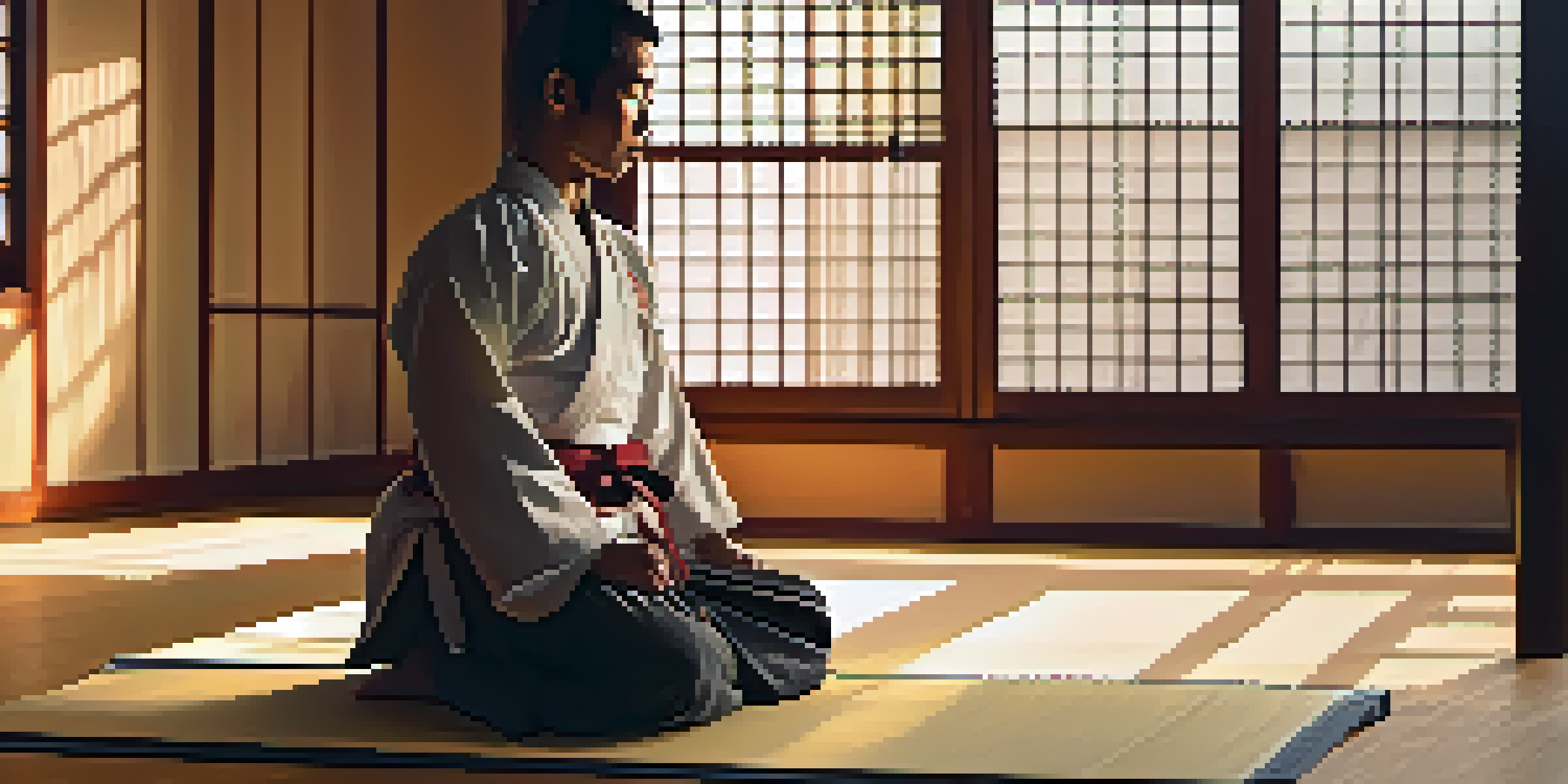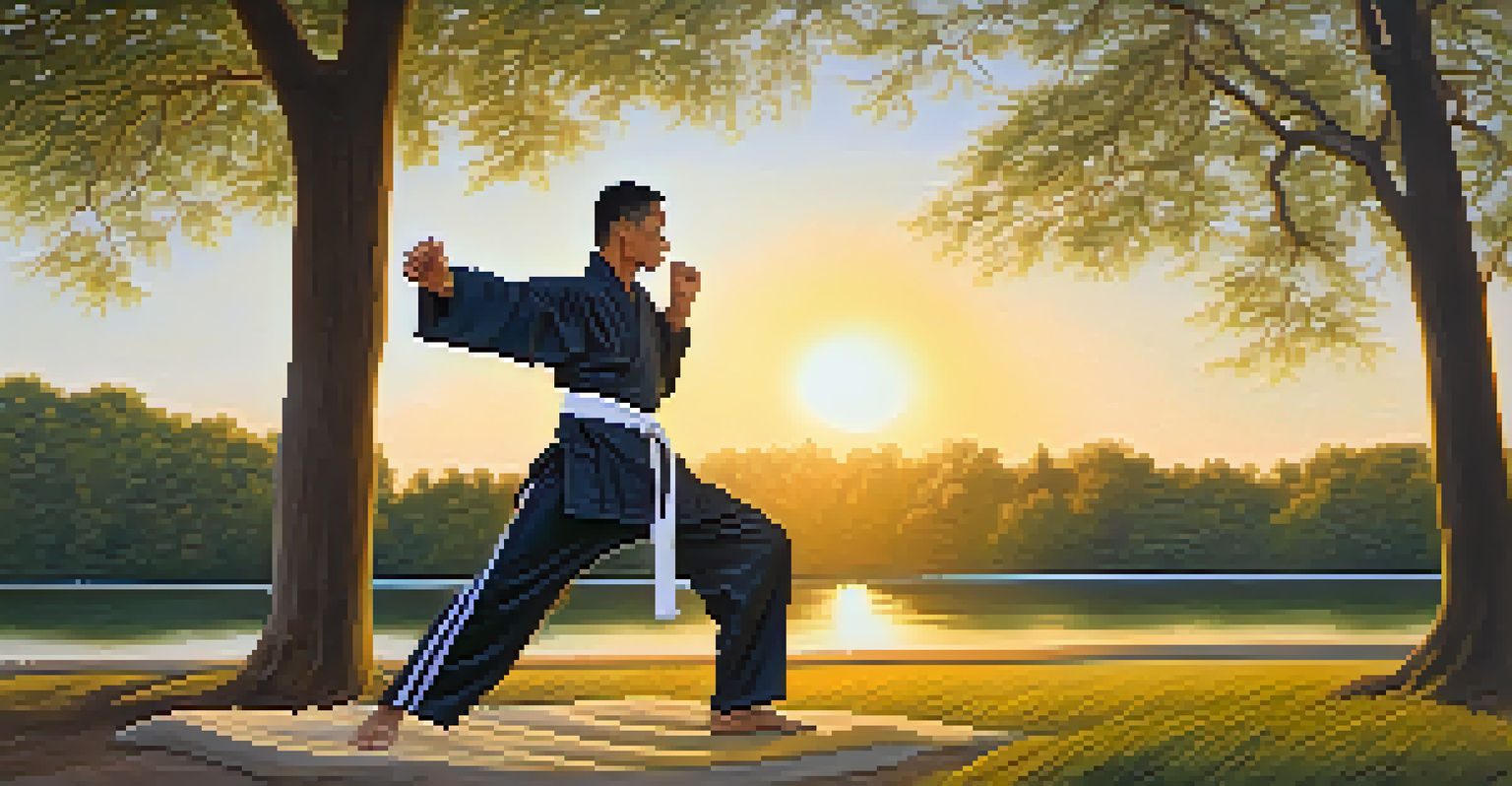How Mindfulness in Martial Arts Affects Conflict Management

Understanding Mindfulness in Martial Arts
Mindfulness is the practice of being fully present in the moment, and in martial arts, it plays a crucial role. By focusing on breath and movement, practitioners learn to cultivate awareness and control over their thoughts and emotions. This heightened state of awareness isn’t just beneficial in the dojo; it can translate into everyday life, especially when dealing with conflict.
The mind is everything. What you think you become.
In martial arts, mindfulness allows individuals to react rather than respond impulsively. For instance, a martial artist trained in mindfulness may take a deep breath before engaging in a sparring match, allowing them to assess the situation rather than act on instinct. This principle can easily be applied to real-life conflicts where taking a moment to pause can lead to more thoughtful decisions.
Moreover, mindfulness encourages a non-reactive state of mind. This means that practitioners can observe their emotions without becoming overwhelmed by them. As a result, when a conflict arises, they are better equipped to handle it calmly and effectively, turning potential confrontations into opportunities for resolution.
The Role of Breathing Techniques
Breathing techniques are a cornerstone of mindfulness in martial arts. Controlled breathing not only enhances physical performance but also serves as a tool for emotional regulation. In moments of stress, such as during a disagreement, practitioners can use these techniques to center themselves and reduce anxiety.

For example, a martial artist might employ deep, rhythmic breathing before entering a tense negotiation. This practice helps to lower the heart rate and create a sense of calm, allowing for clearer thinking and decision-making. The ability to maintain composure in high-pressure situations is invaluable when navigating conflicts.
Mindfulness Enhances Conflict Management
Practicing mindfulness in martial arts cultivates awareness and emotional regulation, leading to more thoughtful responses in conflicts.
Furthermore, these breathing techniques can create a sense of empathy and understanding. When one is calm and centered, it becomes easier to listen actively to the other party's concerns, paving the way for a more constructive dialogue. This empathetic approach can significantly defuse tensions and lead to more amicable outcomes.
Enhancing Emotional Regulation
Emotional regulation is a vital skill in both martial arts and conflict management. Being able to control one’s emotions enables individuals to respond thoughtfully instead of reacting emotionally. In martial arts, practitioners learn to face their fears and frustrations, which builds resilience and self-control.
In the midst of movement and chaos, keep stillness inside of you.
For instance, during a sparring session, an individual may experience frustration when they are bested by a partner. Mindfulness teaches them to acknowledge that emotion, process it, and refocus on their technique. This practice not only improves their martial arts skills but also translates to better management of emotions during conflicts.
The ability to regulate emotions creates a more balanced perspective in conflict situations. When faced with criticism or disagreement, a mindful practitioner can maintain a level head, allowing them to see the situation from multiple angles. This balanced perspective fosters collaboration rather than escalation.
Building Confidence through Mindfulness
Confidence is another key element nurtured through mindfulness in martial arts. As practitioners become more aware of their skills and emotions, they develop a stronger sense of self. This confidence can be incredibly beneficial when addressing conflicts, as it promotes a sense of security in one’s perspective.
Imagine a martial artist stepping into a debate or discussion with the same poise they exhibit in their training. This confidence allows them to articulate their thoughts clearly and assertively, without aggression. They know their worth and understand that healthy conflict can lead to growth.
Breathing Techniques Promote Calm
Controlled breathing aids emotional regulation, helping practitioners maintain composure during stressful situations.
Moreover, this confidence is infectious; it can influence others involved in the conflict. When one party approaches a conversation with assurance and calm, it encourages the other party to respond in kind. This dynamic can transform a potentially hostile situation into a productive exchange.
Mindfulness and Active Listening
Active listening is a critical component of effective conflict management, and mindfulness enhances this skill significantly. When individuals practice mindfulness, they develop a deeper awareness of the present moment, allowing them to engage fully in conversations. This means not just hearing the words but understanding the emotions and intentions behind them.
For example, during a disagreement, a mindful practitioner will focus on the speaker, making eye contact and acknowledging their feelings. This level of engagement fosters trust and respect, making it easier for both parties to communicate openly. Active listening can often de-escalate tensions before they escalate into full-blown conflicts.
Additionally, practicing active listening can lead to more constructive outcomes. By truly understanding the other person's point of view, a mindful practitioner can identify common ground and work towards a solution that benefits everyone involved. This collaborative approach is at the heart of effective conflict resolution.
Cultivating Patience in Conflict Situations
Patience is a virtue that is often tested during conflicts, and mindfulness in martial arts cultivates this essential trait. Practicing martial arts requires time and perseverance, teaching individuals that mastery comes with practice and patience. This understanding is invaluable when faced with challenging interpersonal issues.
In a heated moment, a martial artist trained in mindfulness may recognize the importance of patience and choose to take a step back. This pause allows time for cooler heads to prevail, often preventing rash decisions that could exacerbate the situation. The ability to wait for the right moment can lead to more effective resolutions.
Active Listening Fosters Understanding
Mindfulness enhances active listening, allowing individuals to engage fully in conversations and resolve conflicts constructively.
Moreover, cultivating patience can help in managing expectations. Often, conflicts arise from unmet expectations, and a patient approach allows one to navigate these feelings constructively. By adjusting their perspective, mindful individuals can focus on finding solutions rather than dwelling on problems.
Applying Martial Arts Mindfulness in Daily Life
The principles of mindfulness learned in martial arts can be applied to various aspects of daily life, especially in conflict management. Whether it’s in the workplace, at home, or in social situations, these skills can enhance interactions and promote harmony. Practicing mindfulness outside of martial arts sessions reinforces these techniques.
For instance, someone might use mindful breathing before a challenging conversation at work, helping them stay focused and calm. This not only aids in managing their own emotions but also sets a positive tone for the discussion. Such applications of mindfulness can lead to smoother interactions and improved relationships.

Ultimately, the lessons derived from martial arts can enrich one’s life far beyond the dojo. By integrating mindfulness into everyday situations, individuals can become more adept at handling conflicts, fostering understanding, and promoting cooperation in their communities.